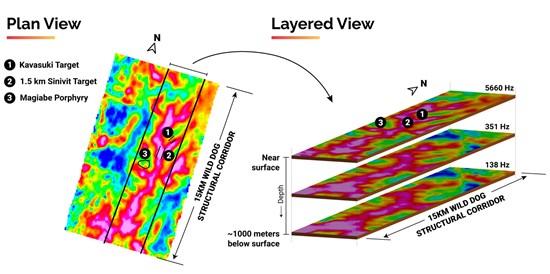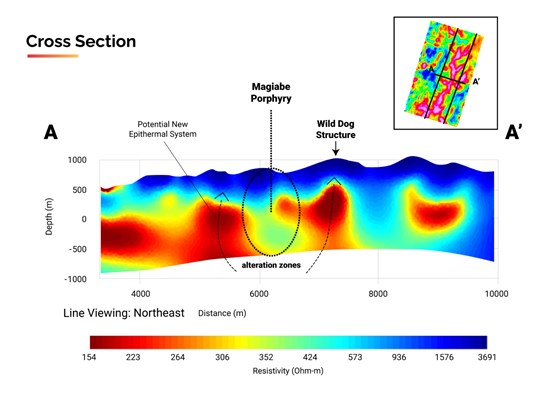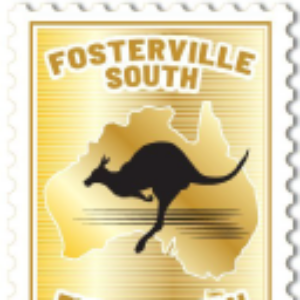Large Scale Epithermal System and Porphyry Potential Highlighted by MobileMT Survey at Great Pacific Gold's Wild Dog Project
Rhea-AI Summary
Great Pacific Gold (OTCQX: FSXLF) has reported significant findings from its MobileMT survey at the Wild Dog Project in Papua New Guinea. The survey revealed a large-scale epithermal system extending over 15km in strike length and reaching depths of 1,000 meters. The company identified the Magiabe copper-gold porphyry target, located 1.5km west of the Wild Dog epithermal vein, featuring a potassic core approximately 1,000 meters in diameter extending to over 2,000 meters depth.
Recent sampling at Magiabe returned promising results, with sample 30012 grading 2.5 g/t Au and sample 30008 showing 0.25% Cu. The company's ongoing diamond drill program has already demonstrated the high-grade nature of the epithermal system, with hole WDG-02 intercepting 7.0 meters at 11.2 g/t AuEq. Great Pacific Gold plans to advance Magiabe towards drill-readiness in 2026, while continuing its epithermal drilling campaign through 2025.
Positive
- Discovery of extensive 15km strike length epithermal system with 1,000m depth potential
- High-grade drill results showing 7.0m at 11.2 g/t AuEq from hole WDG-02
- Identification of large Magiabe porphyry target with 1,000m diameter potassic core
- Promising sample results from Magiabe showing up to 2.5 g/t Au and 0.25% Cu
Negative
- Magiabe porphyry target remains untested by drilling
- Drill program currently testing only 10% of the overall structure
News Market Reaction 1 Alert
On the day this news was published, FSXLF declined 0.70%, reflecting a mild negative market reaction.
Data tracked by StockTitan Argus on the day of publication.
Vancouver, British Columbia--(Newsfile Corp. - August 18, 2025) - Great Pacific Gold Corp. (TSXV: GPAC) (OTCQX: FSXLF) (FSE: V3H) ("Great Pacific Gold," "GPAC," or the "Company") is providing an update on its Wild Dog Project ("Wild Dog" or the "Project"), located on the island of New Britain, in the province of East New Britain, Papua New Guinea ("PNG").
A diamond drill program is currently underway at Wild Dog designed to test high-priority targets over a 1.5km strike length within the epithermal vein structural corridor. The high-grade nature of the epithermal system has been evidenced by multiple intercepts, including hole WDG-02 which intercepted 7.0 meters at 11.2 g/t AuEq (5.5 g/t Au, 68.8 g/t Ag,
Prior to the start of drilling, the Wild Dog corridor was flown with MobileMT geophysics. Processing of the MobileMT data has further highlighted the scale of the epithermal system and the potential for a major porphyry system adjacent to the epithermal vein structure, analogous to the Wafi-Golpu project.
Key Highlights:
- Identified multiple high-sulphidation and low-sulphidation epithermal gold-copper targets over a 15km strike length of the Wild Dog vein system, including the Sinivit area where diamond drilling is currently underway and the nearby Kavasuki vein system (Figure 1).
- Processed data shows epithermal target extends to a depth of at least 1,000 meters (Figure 2).
- Highlighted Magiabe copper-gold porphyry target about 1.5km west of the Wild Dog epithermal vein. The interpreted potassic core of the system is approximately 1,000 meters in diameter and extends to over 2,000 meters in depth (Figure 3).
- Conducted recent fieldwork at Magiabe to support historic work. Samples from the float at Magiabe (Figure 4) returned strong porphyry pathfinder element signatures and Cu-Au. Sample 30012 graded 2.5 g/t Au, 124 ppm Cu, 9.1 g/t Ag and 24 ppm Mo and sample 30008 graded 0.12 g/t Au,
0.25% Cu, 5.6 g/t Ag and 208 ppm Mo. - Elevated Magiabe exploration plans and work is now underway to advance Magiabe towards drill-readiness in 2026.
"The Wild Dog epithermal vein structure's high-grade nature has been evidenced by the drilling results from our Phase 1 program to-date," stated Greg McCunn, CEO. "The processing of the Mobile MT data further highlights that the Wild Dog structure is massive, with over 15km of strike length and depth extension to over 1,000 meters highlighted by the data. Our current drilling program is only testing about
"We will continue to prove up both the grade and scale in the epithermal system with our continued diamond drilling through the remainder of 2025. In addition, Magiabe represents a convergence of historical clues and modern exploration data all pointing to a significant porphyry copper-gold deposit. This target adds a new dimension to the Wild Dog Project, complementing the high-grade near-surface gold potential with a longer-term opportunity to uncover a large porphyry system. Magiabe is expected to be a priority exploration focus moving forward, and the Company is poised to aggressively pursue this porphyry prospect in parallel with its ongoing epithermal drill campaign."
| Figure 1: Apparent conductivity (5660 Hz) highlighting 15km strike length of epithermal system containing Sinivit and Kavasuki. Section A - A' for use in Figure 3 below. | Figure 2: Apparent Conductivity slices through the 15km strike length of epithermal system with highest frequency slice representing near surface and lowest frequency slice representing approximately 1,000 meters in depth. |
To view an enhanced version of this graphic, please visit:
https://images.newsfilecorp.com/files/11018/262802_c517f5e724afbac9_002full.jpg
Magiabe Porphyry Target
The Wild Dog Project area is located along PNG's circum-Pacific "Rim of Fire" arc, an environment known for world-class porphyry Cu-Au and epithermal gold deposits. At Magiabe, field mapping has identified a multiphase quartz diorite-monzonite porphyry intrusion exposed in the Magiabe Creek valley. This intrusion exhibits strong potassic alteration (e.g. secondary K-feldspar, magnetite) and is associated with an intensely phyllic-altered pebble breccia (approximately 250 m in diameter) at surface. Importantly, the Magiabe porphyry intrusive is interpreted to be coeval with the epithermal mineralization in the adjacent Nengmutka/Wild Dog vein system, suggesting a genetic link.
Historic explorers recognized Magiabe as a probable porphyry centre: the presence of mapped intrusives, breccia, porphyry-style alteration, a copper soil anomaly, and coincident geophysical signatures (magnetic high and IP chargeability) led to the interpretation that Magiabe could be the source of the Wild Dog epithermal veins. Supporting this, the Wild Dog veins themselves contain anomalous molybdenum and tellurium (elements often associated with porphyry systems) and a gold-copper association, which reinforced the Magiabe porphyry model in earlier studies. Despite these encouraging signs, the Magiabe porphyry target remained untested by drilling.
The processed MobileMT data have illuminated a compelling porphyry signature at Magiabe. In particular, a large resistivity and magnetic anomaly consistent with a potassic-altered intrusive body is centred at Magiabe. This feature, interpreted as the potassic core of a porphyry system, measures roughly 1,000 meters in diameter and extends to at least 2,000 meters depth in the 3D inversion models. Such scale is comparable to major porphyry deposits; for example, the Wafi-Golpu system's porphyry centre (Golpu) is on the order of 1-2 km across and over 1 km vertical extent. The MobileMT shows the Magiabe anomaly adjacent to and beneath the Sinivit epithermal zone, closely resembling the classic geometry of an epithermal deposit above or alongside a porphyry intrusion. The Magiabe target appears as a deep, robust conductivity/resistivity anomaly and gives GPAC a high-priority porphyry drill target.
Figure 3: Resistivity cross section highlighting the Magiabe porphyry system, along with the Wild Dog epithermal system. A further epithermal target may be present to the west of Magiabe.
To view an enhanced version of this graphic, please visit:
https://images.newsfilecorp.com/files/11018/262802_c517f5e724afbac9_003full.jpg
A 3D IP (Induced Polarization) survey in 2010 identified a circular chargeability anomaly ~200 m in diameter at Magiabe, coincident with a zone of advanced argillic clay alteration at surface. This IP anomaly broadened with depth and was detectable down to ~300 m (the limit of that survey). At surface, the Magiabe area showed a cap of pyrophyllite-dickite-kaolinite alteration (a lithocap) with fine crystalline gold panned in streams and outcrops of dacitic breccia nearby. The IP and mapping data together led geologists at the time to propose a diatreme-related Cu-Au porphyry target at Magiabe, directly drawing parallels to the lithocap above the Wafi porphyry system. Although at least one 300 m exploration hole was recommended to test this chargeability high, the drilling was never undertaken.
The MobileMT survey of 2025 has essentially "unmasked" the deeper parts of this anomaly, revealing the full vertical extent and lateral size of the Magiabe system well beyond the 2010 IP limits. The new data confirms that Magiabe is a sizeable geophysical target consistent with a porphyry intrusive centre, greatly strengthening the exploration rationale.
Field work by historic operators provided geochemical "ground truth" that supports geophysical interpretation of Magiabe as a porphyry Cu-Au system.
Figure 4: Photo of samples taken from the Magiabe porphyry float at Magiabe Creek in February 2020. Sample 30008 is a quartz diorite intrusive with fine-grained copper sulphides and sericite/chlorite alteration. The sample graded 0.12 g/t Au,
To view an enhanced version of this graphic, please visit:
https://images.newsfilecorp.com/files/11018/262802_greatpacific.jpg
In addition to historic work, Great Pacific Gold collected rock float and outcrop samples from the Magiabe area earlier this year (February 2025), and the assays returned strong porphyry pathfinder element signatures.
Great Pacific Gold has accordingly elevated Magiabe in its exploration plans and work is now underway to advance Magiabe towards drill-readiness. This involves detailed mapping, additional geochemical sampling, and possibly ground geophysics over the Magiabe area in the coming months. The goal is to refine drill targets within the broad anomaly.
By 2026, Great Pacific Gold anticipates initiating the first drill testing of the Magiabe porphyry system. PNG is known for giant examples (Ok Tedi, Frieda River, Wafi-Golpu, etc.). Magiabe shares many hallmarks with these systems, a strong geophysical footprint, the right geochemical "footprints" at surface, and spatial association with a productive epithermal gold field.
About the Mobile MT Survey
An airborne electromagnetic (EM) and magnetic survey was conducted by Expert Geophysics Pty Ltd. for Great Pacific Gold Corp. The objective was to collect and analyze geophysical data over the Wild Dog Project, located in the Baining Mountains, East New Britain, Papua New Guinea. Using the advanced MobileMT helicopter-borne system, the project aimed to map bedrock structure, identify lithological changes, and detect potential zones of geological alteration and mineralization. The report explains the survey's rationale, scope, and structure, highlighting the integrated approach that combines electromagnetic, magnetic, and VLF (very low frequency) data.
The Wild Dog Project survey covered an area of 191 square kilometers approximately 30 km southwest of Kokopo. A total of 1,536 line-kilometers were flown using an AS 350 B3E helicopter, deploying both an EM receiver and a magnetometer in towed 'birds' below the aircraft. The survey lines were oriented NW-SE at 100 to 200-meter intervals, with tie lines running perpendicular at 2,000-meter spacing. Average flight altitudes were carefully managed to optimize data quality, with the EM bird maintained at about 173 meters above ground. Detailed coordinates and flight path layouts ensured comprehensive and systematic area coverage.
Operations were based in Kokopo and spanned from March 20 to April 15, 2025, encompassing 20 production flights. The project included equipment mobilization, on-site assembly, system testing, daily acquisition, and demobilization phases.
State-of-the-art equipment underpinned the survey. The core MobileMT system measures natural electromagnetic fields using three orthogonal induction coils, complemented by a precision cesium magnetometer for magnetic data. A GPS-based navigation system and radar altimeter ensured precise positioning. On the ground, a stationary base station recorded reference electric fields, enhancing the accuracy and interpretability of the airborne measurements. The suite also included a digital data acquisition and processing workstation, enabling real-time quality checks and preliminary data processing in the field.
After acquisition, data were rigorously processed using proprietary methods. Electromagnetic data from the airborne and base sensors were synchronized and transformed using advanced algorithms to produce conductivity and resistivity models at various depths and frequencies. Magnetic data underwent corrections for natural field variations and leveling to eliminate noise and bias, then were gridded for visualization. VLF data from global transmitters were filtered and imaged to identify conductive zones. Final data products include digital databases, grids, maps, cross-sections, depth slices, and 3D models, all delivered in standard industry formats for seamless integration with other exploration datasets.
The survey products provide a detailed, multi-dimensional geophysical understanding of the Wild Dog area. The deliverables consist of synchronized EM, magnetic, and VLF databases, with associated maps and 3D visualizations for advanced interpretation. This robust data suite supports the identification of potential mineralization targets and informs further exploration decisions. The integrated analysis is designed to maximize exploration efficiency and de-risk subsequent drilling, positioning the project for informed decision-making and value creation.
Further Details about the July 2025 Private Placement
Further to the Company's news release dated July 3, 2025, the Company confirms that the Agents received a total cash commission of
On behalf of Great Pacific Gold,
Greg McCunn, Chief Executive Officer and Director
For further information visit gpacgold.com or contact:
Email: info@gpacgold.com
Tel: +1 778 262 2331
Qualified Person
The technical content of this news release has been reviewed, verified and approved by Callum Spink, the Company's Vice President, Exploration, who is a member of the Australian Institute of Geoscientists, MAIG, and a Qualified Person as defined by National Instrument NI 43-101 Standards of Disclosure for Mineral Projects. Mr. Spink is responsible for the technical content of this news release. Mr. Spink is not independent of the Company.
Quality Assurance / Quality Control (QAQC)
The Company adheres to industry best practices for Quality Assurance and Quality Control. Drill core samples were submitted to Intertek Minerals Ltd. in Lae, Papua New Guinea, an ISO 9001-certified laboratory. Samples were securely sealed in poly-weave bags with single-use tie-locks to maintain chain of custody. Analytical testing was completed using fire assay with additional multi-element MS48 analysis underway.
Diamond drill hole WDG-02 was drilled using a combination of HQ and PQ diameter core. Certified reference materials (standards) and blanks were inserted into the sample stream in accordance with industry-standard protocols. Blanks were routinely inserted after high-grade intervals, and certified standards were included at a frequency of at least
About Great Pacific Gold
Great Pacific Gold's vision is to become the leading gold-copper development company in Papua New Guinea ("PNG"). The Company has a portfolio of exploration-stage projects in PNG, as follows:
Wild Dog Project: the Company's flagship project is located in the East New Britain province of PNG. The project consists of a large-scale epithermal target, the Wild Dog structural corridor, stretching 15km in strike length and potentially over 1,000 meters deep based on a recent MobileMT geophysics survey. The survey also highlighted the Magiabe porphyry target, adjacent to the epithermal target and potentially 1,000 meters in diameter and over 2,000 meters deep. Drilling of the epithermal structure on the Sinivit target has yielded high-grade results, including WDG-02 which intercepted 7.0 meters at 11.2 g/t AuEq from 65m. The current drilling program will extend into 2026 with 5,000 meters planned over 28 holes.
Kesar Project: located in the Eastern Highlands province of PNG and contiguous with the mine tenements of K92 Mining Inc. ("K92"), the Kesar Project is a greenfield exploration project with several high-priority targets in close proximity to the property boundary with K92. Multiple epithermal veins at Kesar are on strike and have the same orientation as key K92 deposits, such as Kora. Exploration work to date by the Company at the Kesar Project has shown that these veins have high grades of gold present in outcrop and very elevated gold in soil grades, coincident with aeromagnetic highs. The Company conducted a diamond drill program on key target areas at the Kesar Project from November 2024 to May 2025 and are working on developing a follow up Phase 2 program for Q1 2026.
Arau Project: also located in the Eastern Highlands province of PNG, the Arau Project is south of and contiguous to the mine tenements of K92. Arau contains the highly prospective Mt. Victor exploration target with potential for a high sulphidation epithermal gold-base metal deposit. A Phase 1 Reverse Circulation drilling program was completed at Mt. Victor in August 2024, with encouraging results. The Arau Project includes the Elandora licence, which also contains various epithermal and copper-gold porphyry targets.
The Company also holds the Tinga Valley Project in PNG.
Forward-Looking Statements
Information set forth in this news release contains forward-looking statements that are based on assumptions as of the date of this news release. These statements reflect management's current estimates, beliefs, intentions and expectations. They are not guarantees of future performance. Great Pacific Gold cautions that all forward-looking statements are inherently uncertain and that actual performance may be affected by many material factors, many of which are beyond their respective control. Such factors include, among other things: risks and uncertainties relating to Great Pacific Gold's limited operating history, its exploration and development activities on its mineral properties and the need to comply with environmental and governmental regulations. Accordingly, actual and future events, conditions and results may differ materially from the estimates, beliefs, intentions and expectations expressed or implied in the forward-looking information. Except as required under applicable securities legislation, Great Pacific Gold does not undertake to publicly update or revise forward-looking information.
Mineralization at the properties held by K92 Mining is not necessarily indicative of mineralization at the Kesar Project.
Neither TSX Venture Exchange nor its Regulation Services Provider (as that term is defined in the policies of the TSX Venture Exchange) accepts responsibility for the adequacy or accuracy of this release.
Notes:
- See news release dated June 5, 2025 for details, updated for silver results. Drill highlights presented above are core lengths (true widths are not known at this time). Gold equivalent (AuEq) exploration results are calculated using longer-term commodity prices with a copper price of US
$4.50 /lb, a silver price of US$27.50 /oz and a gold price of US$2,000 /oz. No metallurgical testing has been carried out on Wild Dog mineralized samples. For AuEq calculations, recovery assumptions of Au92.6% , Ag78.0% , and Cu94.0% were used based on K92 Mining's stated recovery results in an Updated Definitive Feasibility Study for the Kainantu mine.

To view the source version of this press release, please visit https://www.newsfilecorp.com/release/262802











